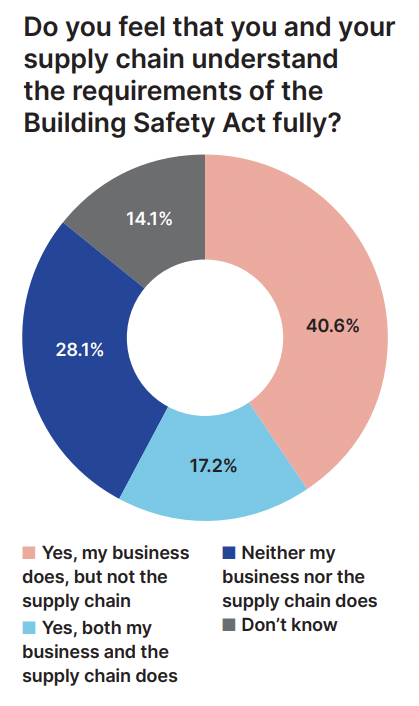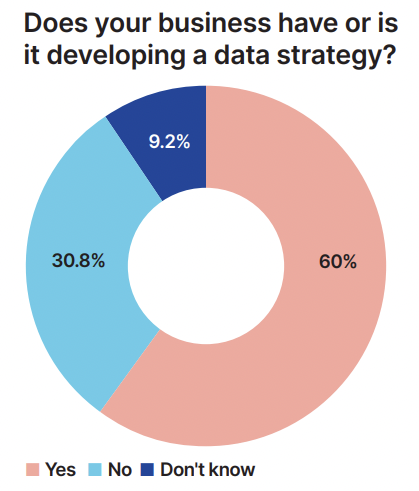
The annual Construction Management and BIMplus survey highlights confusion about the Building Safety Act, but also reveals some good news about data.
Do you feel like you’ve got a full understanding of the requirements of the Building Safety Act? What about your supply chain?
Those were two of the key questions in this year’s Construction Management and BIMplus digital construction survey.
Less than a fifth of respondents said that both their business and their supply chain understands the Building Safety Act. Two-fifths said their business – but not their supply chain – understands the requirements, but, rather worryingly, more than a quarter said that neither their business nor their supply chain is up to speed.
We asked respondents to share their thoughts about the Act. The most compelling responses highlight very real worries at the coalface. “Another piece of legislation that has not been practically thought out or trialled,” said one respondent.

“It’s still grey in too many areas and there is too much other legislation and PAS requirements that confuse the situation,” said another.
The lack of clarity was echoed by other respondents. “Too little training, very vague information, implementation should have been a step change as opposed to a huge undertaking at once,” said one.
“There is no clear framework of guidance from the regulator – everyone is making it up as they go along with their own interpretation of what is required,” bemoaned another.
One respondent dived into aspects of the golden thread: “[There are] unclear definition and requirements about data and BIM – where to host it for compatibility, no client buy-in to supply a common data environment for an ultimate golden thread of non-siloed workflow.”
Golden thread and interoperability
One of the key tenets of the golden thread – as that respondent alludes to – is that information and documents should be able to be transferred electronically to other persons without the data contained therein being lost or corrupted. This, plus a desire to remove inefficiencies, is why interoperability of software is deemed a necessity by so many in the industry. It’s also why the GIIG (formerly the Government & Industry Interoperability Group, now part of nima) launched the code of practice for interoperability last year.
Should BIM be a profession?
At the recent Women in BIM London conference, University of Central Lancashire principal lecturer Dr Jenni Barrett referred to BIM and information management as “an emerging profession”. With that in mind, we asked: “Is it time for information management and BIM to be recognised as a profession?”
Three-quarters of respondents said ‘yes’. One respondent told us: “As a BIM/IM manager, I have worked tirelessly in my companies and positions for the past 12 years – it would be good to finally get some recognition.”
Another said: “There is an intrinsic need to understand and operate the creation of BIM information that requires a level of professionalism that should be recognised.”
One respondent thought a formal move towards professionalism would help ensure consistent advice: “There are experts in this area, but not enough, and without a unified code of practice, advice is often conflicting.”
However, not everyone is convinced, with two respondents concerned that such a move would create a new silo. One said: “Information management should be part of each profession’s skill set. A separate information management profession would get in the way.”
Another said: “If BIM becomes a profession, there is a risk that people who are not seasoned construction professionals will add levels of complexity that are not required.”
This was followed by construction technology giants Autodesk and Nemetschek entering into an interoperability agreement this spring.
Which sounds like the industry is moving in the right direction. But during a Digital Construction Week presentation in June, one innovative technology provider working for a well-known major contractor proposed – with tongue barely in his cheek – that maybe interoperability means employing someone to transfer data or information from one platform to another (rather than it happening seamlessly via an API, for example).
With all this in mind, we asked whether interoperability is still a concern – and more than half of the respondents told us it is.
Tech stack reviews
This led us to ask about technology stack reviews. A significant minority of respondents (47.2%) reported that their business has not undertaken such a review in the past years, but a similarly large minority (41.6%) said reviews have taken place.
The open responses reveal very different experiences, even among respondents whose businesses have conducted reviews. One such told us: “It was reviewed and found woefully lacking. [We’re] in the process of modernising.”
One upbeat respondent said: “Continually. Changes in new tech has enabled some development to be advanced, with some confidence.”
One unhappy respondent, possibly with a shrug of their shoulders, said: “No big issue. With an outdated IT team leading clueless contractors, I’m fighting a losing battle.”
Another respondent with a similar experience said: “Yes, it proved what we knew already. Mostly disconnected and dumb data!”
On top of your data?
And talking of data, without it and information, construction projects are impossible to manage. With so much digital construction technology available with the ability to drown an operation in data and information, having a data strategy in place is vital.

It’s pleasing to report that nearly two-thirds of the survey respondents said that their business either has or is developing a data strategy.
If you have or are developing a data strategy, data literacy will be on your radar. Nearly two-thirds of respondents said they are concerned about data literacy in their business.
So, how are data and data literacy being addressed? This open question produced a predictably mixed set of response.
“Inconsistently. I don’t think everyone realises what is relevant to them,” said one respondent, Another simply answered: “In an ad hoc way.”
One respondent sounded like they were pushing water uphill in their business: “It isn’t. Management do not understand or wish to comprehend the intricacies and importance of good project data and the need for integrating data into a model.”
But it’s not all pessimism: some businesses are taking the right steps. One respondent said their business is concentrating on recruiting the right senior staff while investing in data literacy apprenticeships for existing staff.
Another respondent noted that they are focusing on data quality and governance with input from data stewards.
One respondent highlighted their approach thus: “By understanding the business impact of data literacy, individuals can appreciate its value and prioritise learning the necessary skills.”
What about AI?
We also took the opportunity to tackle the hot potato of the last 18 months, namely AI. We asked: “Do you have a strategy for the use of AI?” Just a fifth answered affirmatively. This is, perhaps, unsurprising and highlights the lack of engagement on a mass scale with AI-powered tools. Nearly three-quarters said they have no strategy for AI.
AI should be ramping up corporate agendas now: the AI law is already in place in the EU, and the recent King’s Speech contained a brief mention of the expected AI law for the UK.
We’ll return to this topic in next year’s survey, by which time CIOB’s AI playbook should have garnered further traffic and industry engagement since its launch in June this year. If you haven’t read the AI playbook yet, you should do so.
Don’t miss out on BIM and digital construction news: sign up to receive the BIMplus newsletter.














